| Services and Procedures |
|
| Dixie Medical Group Physicians offers the following services to take care of your cardiology concerns from initial assessments to post-operative follow up. Make an appointment today. |
| Services |
- Pre-operative Assessment
- Cardiology Consultation
- Electrocardiograms (EKG)
- Echocardiograms
- Stress tests (Treadmill, Dobutamine)
- Arrhythmia monitoring/ Holter monitors
- Cardiac Catheterization
|
|
| |
| Operative Procedures |
- Patent Ductus Arteriosus (PDA) closure
- Coronary artery bypass grafting (CABG)
- Mitral Valvuloplasty
- Transcatheter Aortic Valve Replacement (TAVR)
|
|
| Pre-operative Assessment |
| If you require a cardiology surgery, you will need to see a cardiologist to make sure you are ready for your procedure. Whether it is open heart surgery and less invasive procedure, this appointment will serve to give you all the information that you will need. If you need any additional blood work or exams this will be addressed. |
| Cardiology Consultation |
| This consultation is a general appointment for anything that concerns the heart. You may have been referred by your Primary Care Physician or just want to talk to a cardiologist about your condition. Maybe you are new in town or just need a new cardiologist, this appointment will involve getting to know you, get your history and establish a diagnosis. |
| EKG |
 |
| At any time, you might need to have an EKG. This is a quick and easy test that can be done in office. |
| Echocardiogram |
| This is an ultrasound of the heart (see Patient Education) that can be ordered by your Physician or one of our Physicians. It takes few minutes, safe and gives the Physician a lot of valuable information about the structure and function of your heart. |
| Stress tests (treadmill or dobutamine) |
 |
- Treadmill: This is another important test that gives the Physician information about how your heart works when it is “stressed”. You will be asked to run on a treadmill and then your heart function will be monitored.
- Dobutamine: If you cannot run on a treadmill, this medication can be used to “stress” the heart and the same evaluations can be done.
|
|
| Arrhythmia monitoring |
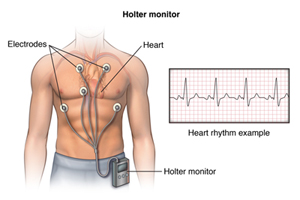 |
| If you have been diagnosed with an abnormal heart rhythm, fainting spells, racing heart feeling, a holter device can be used to monitor your heart rhythms to get an accurate assessment. This holter device will take continuous EKG recordings that can be interpreted by your Physician when you return for follow up. This will clarify the diagnosis. |
| Cardiac Catheterization |
| This is a procedure that involves inserting a dye into the veins to visualize the arteries around the heart. |
| http://www.cardiology-consultants.com/services-diagnostic-cardiology.html |
|
| OPERATIVE PROCEDURES |
| The following topics will walk you through specific operative treatments available to patients. You will find helpful explanations, videos and pictures. |
| Patent Ductus Arteriosus (PDA) and closure |
| What is it? |
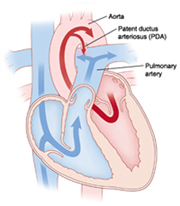 |
A ductus arteriosus is very short vessel connecting the pulmonary artery (the major artery from the heart to the lungs) and the aorta (major artery from the heart to the body). Before birth this vessel is necessary to keep blood away from the underdeveloped lungs, but after birth the lungs open up and this connection is no longer necessary so it closes on its own within the first day of life. For some newborns this does not happen and the vessel remains open, this is called a patent ductus arteriosus or PDA. |
- When the PDA is small there are no major symptoms. For larger PDAs the infant will start to show symptoms as oxygenation of their blood is affected. If this persists to adulthood chest pain,
|
|
|
| shortness of breath, fainting and migraines can alert the Physician that something is wrong and further tests are ordered. The PDA must be closed to prevent progression into heart failure and other complications. |
| How is it diagnosed? |
- Echocardiogram
- Chest Xray
|
|
| How is it treated? |
| Medical treatment involves use of medications that close the PDA in premature babies (Indomethacin or Ibuprofen). This only works at the time of birth. The patient will likely require a percutaneous operation which is a minimally invasive surgical approach that closes the PDA through a small catheter that goes in through the skin. This is commonly done once the child is older than 1 year. If the PDA is large a surgical procedure might be necessary. This involves open heart surgery to get in to the heart and close it from within. |
| http://www.youtube.com/attribution_link?a=iEdLxfSaYPY&u=/watch%3Fv%3DpvUtBqJEvk8%26feature%3Dem-share_video_user |
|
| What are possible surgical complications ? |
- Pneumothorax (air around the lungs)
- Half lung paralysis causing difficulty breathing (phrenectomy)
- Hoarseness, loss of voice (injury to recurrent laryngeal nerve)
- Thoracic duct injury
- Mortality rate is almost 0% and longtime survival is normal.
|
|
|
| Coronary artery bypass graft (CABG) |
| What is it? |
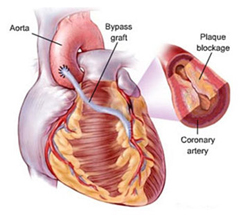 |
A coronary artery bypass graft is a surgical operation that patients with heart attack or significant stenosis (narrowing) of one of the heart vessels get to replace one or more occluded sections with a graft or vessel from elsewhere. The graft is usually taken from a vein in the leg. |
| CABG is a major heart surgery. The patient is placed under anesthesia. The chest is opened, the heart is stopped to allow the surgeon to work on the vessels, heart lung machine is connected continue to supply oxygenated blood to the body, the graft is obtained from the greater saphenous vein in the leg The graft is then implanted and blood flow to the affected area is restored. The heart-lung machine is stopped, re-starting the heart and the chest is closed. |
|
| After the surgery, the patient will spend 3 – 5 days in hospital to monitor the heart and then discharged home. Symptoms of angina and chest pain will disappear after bypass surgery. CABG works best in preventing future heart attacks when accompanied with smoking cessation, proper nutrition, exercise as tolerated and taking prescribed medications. |
| Video: https://www.youtube.com/watch?v=WM_tcf5Ogy0 |
|
| Coronary artery bypass graft (CABG) |
| What is it? |
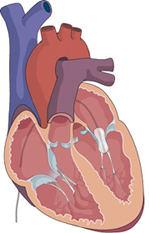 |
This is a corrective procedure for some patients with mitral stenosis. Mitral stenosis is a condition that occurs when the valve between the left atrium and ventricle is too small and prevents normal flow of blood. Therefore a procedure is often necessary to open up the valve to restore normal flow. This procedure is called mitral valvuloplasty and involves inserting a special balloon catheter through a needle into the vein and advancing it to the heart to the position of the mitral valve. The balloon is then inflated to open up the valve. |
| It is a safe procedure that only takes. |
| Video: http://www.nebraskamed.com/health-library/3d-medical-atlas/271/mitral-valvuloplasty |
|
| |
|
| |
| Transcatheter Aortic Valve Repair (TAVR) |
| What is the procedure for? |
| Transcatheter aortic valve repair is a procedure used to treat patients with aortic stenosis (narrowing of the aortic valve). Aortic stenosis restricts blood from leaving the heart and getting to the aorta therefore preventing blood from properly pumping to the body. This forces the heart to work harder and function at higher pressures in order to get the blood to the body. Over time the heart begins to tire and become weak and heart failure occurs. This disease affects mostly the elderly because it develops slowly over several years. |
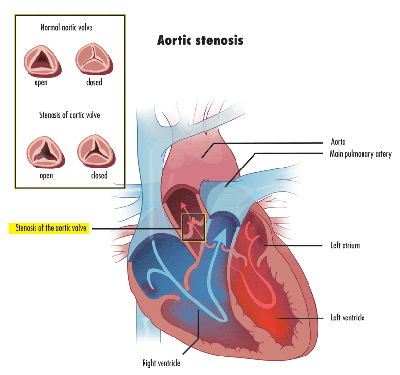 |
| Symptoms of heart failure are shortness of breath, coughing, swelling of the feet, exercise |
|
| intolerance, lightheadedness, chest pain and eventually difficulty breathing after very little activity. This decreases quality of life because it limits the activities the patient can do. In earlier stages of the disease medications are given to decrease the strain on the heart but as the disease progresses these medications may become less efficient and surgical options are considered. The ideal procedure is open heart surgery but if the patient is not able to undergo an open heart surgery withstand the stress of such a major operation; there is a second less invasive option: Transcatheter aortic valve repair (TAVR). This procedure is less involved, shorter in duration as well as recovery time because it does not require opening up the chest and heart. It is a fairly new procedure but offers great results. |
| Procedure preparation |
| Patient must see the cardiology team (surgeons, interventional cardiologists and anesthesiologists) for evaluation. Once selected and approved as a candidate they must undergo several tests: |
- Echocardiogarm
- ECG
- Cardiac catheterization
- Blood Work
|
|
| They are then seen by an anesthesiologist to verify medications and get them ready. After the procedure is explained, consent is signed and the patient is scheduled for the procedure. |
| How is it performed? |
| After being placed under anesthesia, a catheter (small long tube) is inserted through a needle into a vein and pushed up into the heart into the area of the aortic valve. There are several approaches: |
- Transfemoral (through a vein in the groin area).
- Aortic
- Subclavian
- Transapical (small incision made in the chest into the tip of the left ventricle (apex)
|
|
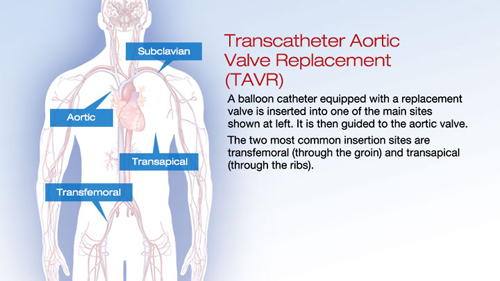 |
| Video: http://www.youtube.com/watch?v=X1Uk9Jvbut0 |
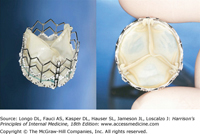 |
 |
There are different types of devices that can be used. Tissue valves are made from animal tissue. It usually lasts 10-15 years and is used more in older patients. |
|
 |
Mechanical valves are artificial valves that are made to last long and are therefore used more in younger patients. If this valve is chosen a blood thinner must be taken for life to prevent clots.
The new valve is properly placed using Xrays and echocardiogram for guidance. Once the valve is properly positioned the catheter can be removed. A drain is placed to allow blood and fluid to leak out. The procedure takes about 2 hours |
|
| How long does it take to recover? |
| It usually only takes about 3 – 5 days stay in the hospital. The patient will spend the first day in ICU and will be closely monitored for arrhythmias and other complications. |
| What happens after the procedure? |
| After being discharged from the hospital the patient can return home. The drain is removed and incision site wounds are examined. Within a couple months, symptoms should decrease, trips to the hospital should decrease and quality of life should improve. Certain medications are started or restarted including blood thinners, aspirin, and PPI (to protect the stomach). Follow up appointments are made after 1 month, 6 months and 1 year to re-evaluate symptoms, echocardiogram to assess heart and valve function and review medications. |
| |